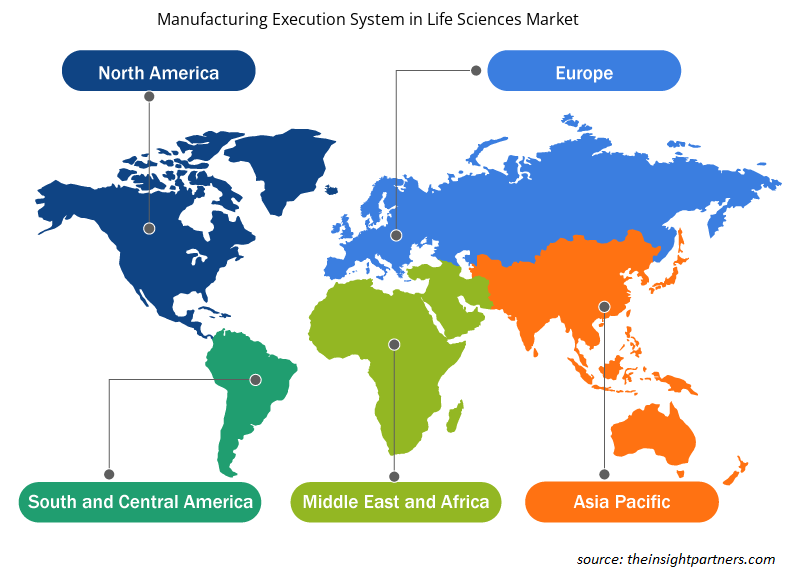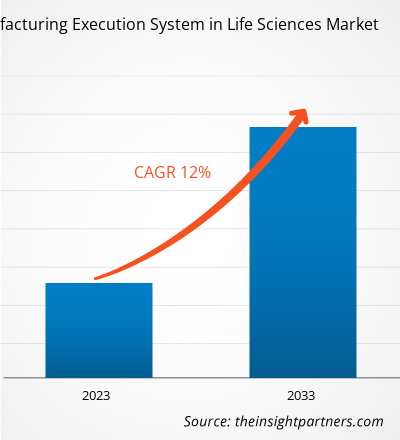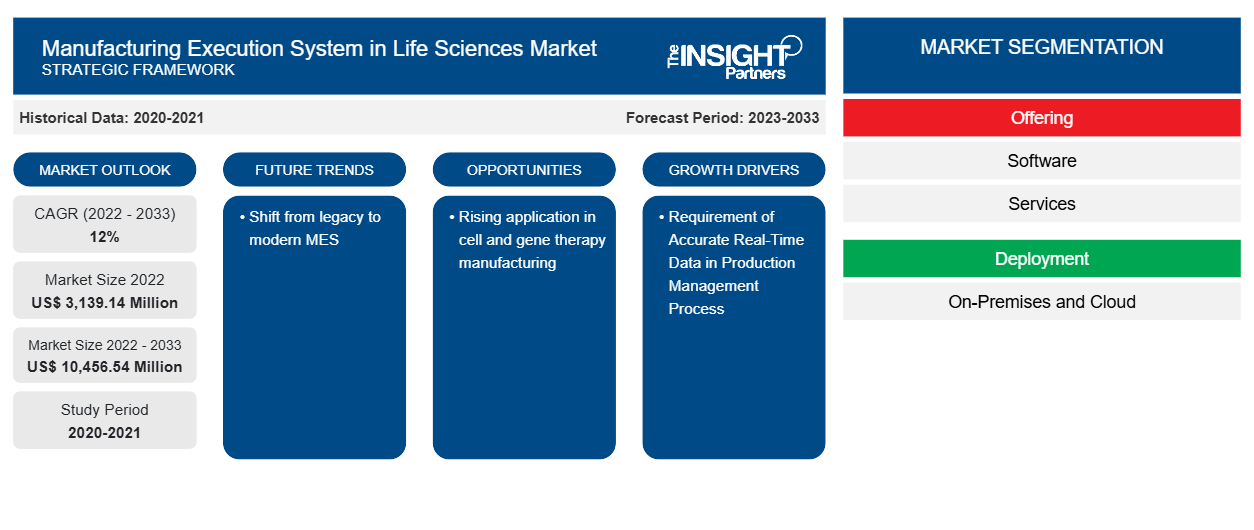生命科学制造执行系统市场规模预计将从 2022 年的 31.3914 亿美元增至 2033 年的 104.5654 亿美元。预计 2023-2033 年期间市场复合年增长率将达到 12%。从传统 MES 向现代 MES 的转变可能仍是市场的主要趋势。
生命科学制造执行系统市场分析
现代 MES 解决方案正在更多地融入企业资源规划 (ERP) 平台的元素。这使得它们能够提供更好的物流跟踪、物料识别和与生产运营的集成,以及超越传统生产的分布式模型。此外,传统的 MES 解决方案专注于批量制造,如果没有进行大量定制,通常无法提供必要的功能。在预测期内,这些因素预计将促进生命科学研究人员采用现代制造执行系统。
生命科学制造执行系统市场概览
制造执行系统 (MES) 是一种动态的综合解决方案,可帮助跟踪、记录、监控和控制从原材料到成品的制造过程。这些解决方案还为决策者提供多变量数据,可用于优化工厂车间运营并提高生产效率。MES 可以具有扩展功能,通常称为制造运营管理 (MOM) 功能。术语“制造运营管理”定义为 ANSI/ISA-95 企业控制系统集成标准的 3 级。
定制此报告以满足您的需求
您可以免费定制任何报告,包括本报告的部分内容、国家级分析、Excel 数据包,以及为初创企业和大学提供优惠和折扣
- 获取此报告的关键市场趋势。这个免费样品将包括数据分析,从市场趋势到估计和预测。
生命科学制造执行系统的市场驱动因素和机遇
生产管理过程中对实时数据精准性的需求
MES 可以帮助制造商以较少的劳动力运作,从生产过程中收集准确的实时数据,提高流程效率和灵活性,保障监管期望,并实现制造流程数字化。
2022 年 2 月,Integer 宣布已收购 Critical Manufacturing 的制造执行系统 (MES),以提高其全球生产流程的效率和质量。该公司将在其爱尔兰工厂使用该模块来数字化其生产流程,收集实时数据并提高效率、质量和可追溯性。同样,2020 年 9 月,Körber 和 Walvax Biotechnology 宣布已签署协议,在其玉溪疫苗生产工厂实施 Werum PAS-X MES(用于制药、生物技术和细胞与基因治疗制造的 MES)。根据 Körber 的说法,PAS-X MES 允许用户快速、全面、实时地管理、可视化和分析数据。2019 年 8 月,武田爱尔兰有限公司在其位于爱尔兰 Grange Castle 的生产基地分阶段实施了 PAS-X MES,并将其改造成无纸化工厂。市场参与者越来越多地采用 MES 来收集生产管理过程中的准确实时数据,这推动了生命科学市场中制造执行系统的增长。此外,现代 MES 解决方案(通常称为轻量级 MES)具有高度灵活性、可根据需求量身定制、集成各种工具并且基于云。此外,MES 和实验室执行系统 (LES) 还可以帮助降低污染风险、提高数据完整性、降低运营成本、确保法规遵从性和质量,并增强跟踪和追踪能力。由于使用 MES 具有上述所有优势,各种市场参与者都在采用该系统。
细胞和基因治疗制造中的应用日益增多
制药制造业生态系统的关键解决方案提供商之间的合作也越来越多,旨在开发用于细胞和基因治疗产品制造的先进解决方案。2022 年 1 月,TrakCe 与 Korber 合作进行软件集成。此次合作促成了 TrakCel 的 OCELLOS 与 Körber 的 PAS-X 之间的功能集成。预计这将使两家公司的细胞和基因治疗客户能够有效地共享详细说明制造事件和里程碑的数据,例如开始检查、灌装和完成以及产品发布;并提供完整的可追溯性和审计日志。2021 年 10 月,Körber 和 Vineti 宣布合作将 Korber 的 PAS-X MES 与 Vineti 业界领先的个性化治疗管理 (PTM) 平台集成。此次合作将进一步为生物制药客户提供集成的 PAS-X MES 解决方案,这将有助于为有需要的患者带来挽救生命的细胞和基因疗法。因此,预计在预测期内,细胞和基因治疗制造领域的市场参与者对 MES 的应用和采用将为生命科学市场制造执行系统的增长创造机会。
生命科学制造执行系统市场报告细分分析
生命科学市场分析中制造执行系统衍生的关键部分包括产品、部署、组织规模和应用。
- 根据产品供应,生命科学市场中的制造执行系统分为硬件和软件。软件部分在 2023 年占据了更大的市场份额。
- 根据部署,市场分为本地和云端。
- 根据组织规模,市场分为中小型企业和大型企业。
- 根据应用,市场分为制药、生物技术和医疗设备。
生命科学制造执行系统市场份额按地区分析
生命科学制造执行系统市场报告的地理范围主要分为五个区域:北美、亚太地区、欧洲、中东和非洲以及南美和中美。在北美,技术创新预计将为生命科学制造执行系统市场提供增长机会。此外,制药行业制造流程的数字化程度不断提高,推动了该地区生命科学制造执行系统市场的增长。此外,Apprentice FS, Inc、Atachi Systems、Emerson Electric Co、POMS Corporation 和 Rockwell Automation 等市场参与者不断致力于简化医疗保健行业的制造流程,从而推动了生命科学制造执行系统市场的增长。
生命科学市场中的制造执行系统区域洞察
Insight Partners 的分析师已详细解释了预测期内影响生命科学制造执行系统市场的区域趋势和因素。本节还讨论了生命科学制造执行系统市场的各个部分和地理位置,包括北美、欧洲、亚太地区、中东和非洲以及南美和中美洲。

- 获取生命科学市场制造执行系统的区域特定数据
生命科学市场制造执行系统报告范围
| 报告属性 | 细节 |
|---|---|
| 2022 年市场规模 | 31.3914亿美元 |
| 2033 年市场规模 | 104.5654 亿美元 |
| 全球复合年增长率(2022 - 2033 年) | 12% |
| 史料 | 2020-2021 |
| 预测期 | 2023-2033 |
| 涵盖的领域 | 通过奉献
|
| 覆盖地区和国家 | 北美
|
| 市场领导者和主要公司简介 |
|
生命科学市场参与者密度中的制造执行系统:了解其对业务动态的影响
生命科学市场中的制造执行系统市场正在快速增长,这得益于最终用户需求的不断增长,这些需求是由于消费者偏好的不断变化、技术进步以及对产品优势的认识不断提高等因素所致。随着需求的增加,企业正在扩大其产品范围,进行创新以满足消费者的需求,并利用新兴趋势,从而进一步推动市场增长。
市场参与者密度是指在特定市场或行业内运营的企业或公司的分布情况。它表明在给定市场空间中,相对于其规模或总市场价值,有多少竞争对手(市场参与者)存在。
在生命科学市场中运营制造执行系统的主要公司有:
- 西门子股份公司
- 艾默生电气
- 施耐德电气
- 罗克韦尔自动化
- 学徒 FS 公司
- ATS 全球
免责声明:上面列出的公司没有按照任何特定顺序排列。

- 获取生命科学市场制造执行系统顶级关键参与者概述
生命科学制造执行系统市场新闻和最新发展
生命科学市场中的制造执行系统通过收集一级和二级研究后的定性和定量数据进行评估,其中包括重要的公司出版物、协会数据和数据库。以下列出了生命科学市场中制造执行系统的一些发展:
- Lonza 和 NNIT 宣布建立合作伙伴关系,以加速 MES 项目。两家公司将在 Lonza 的 MODA 平台上与 NNIT 的加速实施方法进行合作。(来源:Lonza,新闻稿,2021 年 3 月。)
- AVEVA 是工业软件领域的全球领导者,致力于推动数字化转型和可持续发展,它扩展了其世界领先的工业智能平台 CONNECT,为混合制造执行系统 (MES) 解决方案提供数据和可视化服务。(来源:AVEVA,新闻稿,2023 年 4 月)
生命科学市场制造执行系统报告范围和交付成果
“生命科学制造执行系统市场规模和预测(2023-2033)”报告对以下领域进行了详细的市场分析:
- 生命科学制造执行系统的市场规模以及范围内涵盖的所有关键细分市场的全球、区域和国家层面的预测
- 生命科学市场趋势中的制造执行系统以及驱动因素、限制因素和关键机遇等市场动态
- 详细的 PEST/波特五力分析和 SWOT 分析
- 生命科学制造执行系统市场分析涵盖关键市场趋势、全球和区域框架、主要参与者、法规和最新市场发展
- 行业格局和竞争分析,涵盖市场集中度、热图分析、知名参与者以及生命科学市场制造执行系统的最新发展
- 详细的公司简介
- 历史分析(2 年)、基准年、预测(7 年)及复合年增长率
- PEST和SWOT分析
- 市场规模、价值/数量 - 全球、区域、国家
- 行业和竞争格局
- Excel 数据集
近期报告
客户评价
购买理由
- 明智的决策
- 了解市场动态
- 竞争分析
- 客户洞察
- 市场预测
- 风险规避
- 战略规划
- 投资论证
- 识别新兴市场
- 优化营销策略
- 提升运营效率
- 顺应监管趋势





















 获取免费样品 - 生命科学市场中的制造执行系统
获取免费样品 - 生命科学市场中的制造执行系统